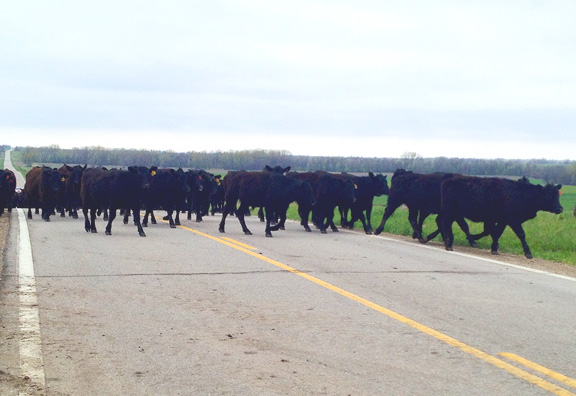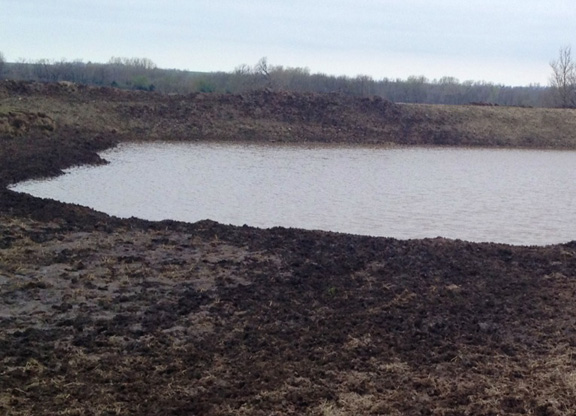 It takes a heap of work, coordination and planning to get a tasty steak from pasture to plate. In honor of National Beef Month, we decided to check in with the people who devote their life’s work to providing, cooking and delivering the Certified Angus Beef ® brand to your table. Come along with us and experience a “Day in the Life” of these fine folks.
It takes a heap of work, coordination and planning to get a tasty steak from pasture to plate. In honor of National Beef Month, we decided to check in with the people who devote their life’s work to providing, cooking and delivering the Certified Angus Beef ® brand to your table. Come along with us and experience a “Day in the Life” of these fine folks.
Today, Debbie Lyons-Blythe, who regularly updates her blog “Life on a Kansas Cattle Ranch,” gives us a snapshot of what Sunday looked like at their place. Enjoy! – Jennifer
Spring is my favorite time of year!
I’m not a winter person — I crave sunshine and warm weather. I wear long johns, coveralls and lots of layers all winter and when spring finally arrives, I am very ready for it! The past couple of years in Kansas we have been dealing with severe drought. Despite some good snowfalls this winter, we began spring expecting the drought to continue. We have ponds that are totally dry and we have spent thousands of dollars finding ways to bring drinking water to the cattle in each pasture. But all that has changed for us in eastern Kansas. Near the end of April, the rain began to fall again and we now have some water in most of our ponds. A few of them are actually full! This past weekend was a time of hope and fun, preparing to take cattle to the pastures.
Spring is also a time to plan matings for our cows and heifers. It is important to keep track of the pedigrees — as well as the calves — of every cow or heifer on our ranch.
[Quick fact: Cattle are often referred to as ‘cows’ — but there are distinctions in the herd. Heifers are young females, on track to become new mothers. Mature female cattle earn ‘cow’ status when they have had two or more calves.]
I carefully plan which bull to breed to each cow. For example, let’s say [mama cow] #1001 has a big, healthy calf every year. Her calves don’t produce high-quality beef, though, so this year I’ll choose a bull [calf daddy] that sires calves with higher-than-average quality traits.
[A sort of cattle call dating service — like that song from Fiddler On the Roof: “Matchmaker, Matchmaker, make me a match, find me a find, catch me a catch; Matchmaker, Matchmaker, look through your book, and make me a perfect match!”]
Last weekend, we called the college kids to come home … to help work the heifers for breeding season. Unfortunately, Meghan was at Virginia Tech putting on the Raising the Bar conference for the National Junior Angus Association and couldn’t help. Allie had to work at the Texas Roadhouse all weekend. Trent said he could come home. Also, Tyler and Eric are juniors in high school. With husband Duane and me and the three boys, we had a great working crew for the weekend!
 The morning we work cattle begins early for me, as I like to make a good stick-to-your-ribs lunch for the working crew. I put meatballs and corn casserole on to cook for the morning and began calling the boys to get up around 7 a.m. At 7:30, I could hear them finally moving and I started gathering up the equipment and medications we needed for the day.
The morning we work cattle begins early for me, as I like to make a good stick-to-your-ribs lunch for the working crew. I put meatballs and corn casserole on to cook for the morning and began calling the boys to get up around 7 a.m. At 7:30, I could hear them finally moving and I started gathering up the equipment and medications we needed for the day.
Duane was already feeding the cows that were not being worked and I brought him a cup of coffee as the boys and I pulled into the barnyard. Duane laid out the plan for the day as he sipped his coffee.
It was a chilly, misty morning and we had to walk the heifers about a mile to get them home where we have our working pens. They had to walk through a lush waterway of brome [various grasses] and around a large alfalfa field. We knew it would be tricky keeping them moving. The lush green grass is a big temptation and they would rather stop to graze than keep moving!
We don’t use horses, but prefer to use a tractor with a feed wagon to lead the heifers, and ATVs and people on foot to keep them moving. With each of us driving one of those vehicles, we started off. There were 200 heifers and a few steers [castrated males] in this pasture. After they walk through the brome and alfalfa field, they will walk a quarter of a mile on the state highway along our property border. I block the few cars at the top of the hill as the heifers trot down the highway!
Do the cattle make it to working pens without incident? How long does it take to work through 200 head? Find out how the rest of the day turned out in Part II, tomorrow.


